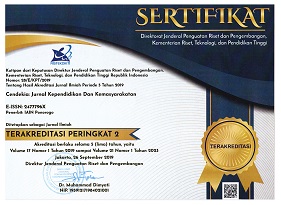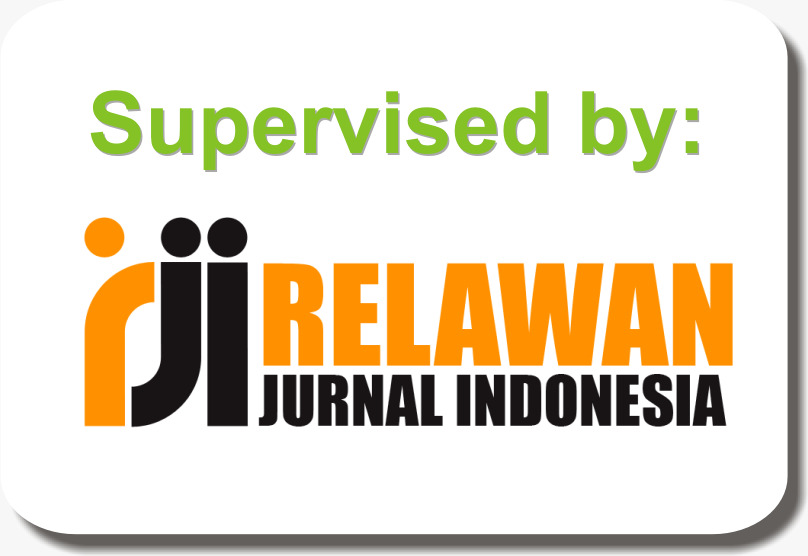Studi Komparasi Metode Eksperimen Inkuiri dengan Eksperimen Verifikasi terhadap Hasil Belajar IPA Materi Perpindahan Kalor
DOI:
https://doi.org/10.21154/cendekia.v15i2.1006Keywords:
Eksperimen inkuiri, eksperimen verifikasi, hasil belajarAbstract
This study aims to compare students' learning outcomes in the subject of heat transfer using an inquiry experimental method and a verification experiment. The sampleswere PGMI class students which were selected using the purposive sampling technique. The datawere gained from the learning result of the cognitive domain of students obtained from the pre-test and post-test scores which were analyzed by using t-test of two variant equations and psychomotor domain learning result. The students' cognitive learning outcome using inquiry learning (N-gain 56.98%) differed significantly higher than that using verification experimental method (N-gain 39.58%). Meanwhile, in term ofpsychomotor aspects covering the skills of assembling tools in practicum, using practicum equipment, performing experiments according to procedures, taking data in practice, and presenting observation, the learning outcomes usinginquiry experimental method and verification experiment were respectively 77.06% and 74.91%. Thus, it revealed that there was no a significant difference between the use of inquiry experimental method and the verification experimental method on psychomotor aspect learning outcomes on the subject of heat transfer.Øاول هذا البØØ« مقارنة نتائج تعلّم الطلاب ÙÙŠ مادة انتقال الØرارة باستخدام طريقة التجربة التØقّقية والتجربة التØقيقية. وعينة هذا البØØ« هو الطلاب ÙÙŠ قسم التربية لمدرسي المدارس الإبتدائية (Ø£) بأسلوب أخذ العينات المتعمدة ØŒ أما بيانات هذا البØØ« Ùهو نتائج الطلاب للجانب المعرÙÙŠ والجانب النÙسØركي المØصولة عليها من الاختبار القبلي والاختبار البعدي وتÙØلّل باستخدام اختبار t ÙÙŠ التشابه ÙÙŠ اثنين بين المتغيّرات. Ùنتائج التعلم للجانب المعرÙÙŠ ÙÙŠ مادة انتقال الØرارة باستخدام طريقة التجربة التØقيقية ( N-gain 56,98%) ويختل٠أكثر وهو أعلى من التعليم باستخدام الطريقة التجربة التØققية. (N-gain 39,58%). ونتائج التعلم للجانب النÙسØركي المشتمل على مهارة تنسيق وتعليق الأدوات المستخدمة ÙÙŠ عمل المختبر، واستخدامها، والقيام بالتجربة طبقا للخطوات المقررة، واتخاذ البيانات ÙÙŠ عمل المختبر، وعرض نتائج الملاØظة باستخدام طريقة التجربة التØقيقية (77.06% ) لا يختل٠كثيرا عن طريقة التجربة التØققية (74,91%) . بهذا لا يوجد Ùرق كبير بين استخدام طريقة التجربة التØقيقية وطريقة التجربة التØققية تجاه نتائج التعلم ÙÙŠ الجانب النÙسØركي ÙÙŠ مادة انتقال الØرارة.
Downloads
Published
Issue
Section
License
Copyright & License
Please find the rights and licenses in Cendekia: Jurnal Kependidikan dan Kemasyarakatan. By submitting the article/manuscript, the author(s) agree with this policy. No specific document sign-off is required.
1. License
The non-commercial use of the article will be governed by the Creative Commons Attribution license as currently displayed on the Creative Commons Attribution-NonCommercial 4.0 International License.
2. Author(s)' Warranties
The author warrants that the article is original, written by the stated author(s), has not been published before, contains no unlawful statements, does not infringe the rights of others, is subject to copyright that is vested exclusively in the author and free of any third party rights, and that any necessary written permissions to quote from other sources have been obtained by the author(s).
3. User/Public Rights
The spirit of Cendekia: Jurnal Kependidikan dan Kemasyarakatan is to disseminate articles published as free as possible. Under the Creative Commons license, Cendekia: Jurnal Kependidikan dan Kemasyarakatan permits users to copy, distribute, display, and perform the work for non-commercial purposes. Users will also need to attribute authors and Cendekia: Jurnal Kependidikan dan Kemasyarakatan on distributing works in the journal and other media of publications. Unless otherwise stated, the authors are public entities as soon as their articles got published.
4. Rights of Authors
Authors retain all their rights to the published works, such as (but not limited to) the following rights;
- Copyright and other proprietary rights relating to the article, such as patent rights,
- The right to use the substance of the article in own future works, including lectures and books,
- The right to reproduce the article for own purposes,
- The right to self-archive the article,
- The right to enter into separate, additional contractual arrangements for the non-exclusive distribution of the article's published version (e.g., post it to an institutional repository or publish it in a book), with an acknowledgment of its initial publication in this journal (Cendekia: Jurnal Kependidikan dan Kemasyarakatan).
5. Co-Authorship
If the article was jointly prepared by more than one author, any author submitting the manuscript warrants that he/she has been authorized by all co-authors to be agreed on this copyright and license notice (agreement) on their behalf and agrees to inform his/her co-authors of the terms of this policy. Cendekia: Jurnal Kependidikan dan Kemasyarakatan will not be held liable for anything arising due to the author(s) internal dispute. Cendekia: Jurnal Kependidikan dan Kemasyarakatan will only communicate with the corresponding author.
6. Royalties
Being an open accessed journal and disseminating articles for free under the Creative Commons license term mentioned, the author(s) are aware that Cendekia: Jurnal Kependidikan dan Kemasyarakatan entitles the author(s) to no royalties or other fees.
7. Miscellaneous
Cendekia: Jurnal Kependidikan dan Kemasyarakatan will publish the article (or have it published) in the journal if the article's editorial process is completed. The editors of Cendekia: Jurnal Kependidikan dan Kemasyarakatan may modify the paper to a style of punctuation, spelling, capitalization, referencing, and usage that deems appropriate. The author acknowledges that the article may be published so that it will be publicly accessible, and such access will be free of charge for the readers, as mentioned in point 3.

















